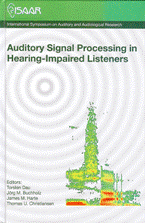The effects of compression ratio and release-time on loud speech and noise signals, processed by a simulated non-linear hearing aid
Abstract
This study investigated the effect of compression ratio and release time on hearing aid wearers’ impressions of loud input signals. Two speech and noise signals, differing in spectra and signal-to-noise ratio, were processed in a model compressor with sixteen combinations of compression ratio and release time. The RMS input level of the signals was 75 dB SPL. Subjects rated the processed signals on categorical scales, in regard to loudness, speech clarity, noisiness and overall acceptance. With a compression ratio between 1.5:1 and 2:1 and a release time of 4000-ms, the highest degree of speech clarity and the lowest possible noisiness was achieved, while still maintaining a positive rating on the acceptance-scale. When shorter release times of 40 and 400-ms were used, ratings of acceptance declined when the compression ratio was 3:1 or greater. Thus, the preferred setting appears to be long release times in combination with a low compression ratio - providing the listener with a realistic loudness for the signal. When faster regulation is needed the compression ratio should not exceed 3:1.
References
ANSI-S3.5 (1997). “American National Standard methods for the calculation of the Speech Intelligibility Index,” New York, American National Standards Institute, Inc.
Kuk, F. K., Ludvigsen, C. (1999). “Verifying the output of digital nonlinear hearing instruments,” Hearing Review, 6(11), p. 35, 36, 38, 60, 62, 70.
Moore, B. C. J., Glasberg, BR., Baer, T. (1997). “A model for the prediction of thresh- old, loudness and partial loudness,” J. Audio Eng. Soc., 45(4), 224-240.
Neuman, A., Bakke, M. Mackersie, C., Hellmann, S., Levitt, H. (1998). ”The effect of compression ratio and release time on the categorical rating of sound quality”, J. Acoust. Soc. of Am., 103(5), 2273-2281.
Neuman, A. C., Bakke, MH., Hellman, S., Levitt, H. (1995b). ”Preferred listening levels for linear and slow-acting compression hearing aids,” Ear & Hearing, 16(4), 407-415.
Pascoe, D. P. (1988). “Clinical measurements of the auditory dynamic range and their relations to formulas for hearing aid gain,” In Proceedings of the 13th Danavox Symposium, edited by J. Hartvig Jenson, 129-151.
Preminger, J., Van Tasell, DJ. (1995). “Quantifying the relation between speech quality and speech intelligibility,” J. Speech Hear. Res., 38, 714-725.
Smeds, K., Keidser, G., Zakis, J., Dillon, H., Leijon, A., Grant, F., Convery, E., and Brew, C. (2004b). “Preferred overall loudness. II: Listening through hearing aids in eld and laboratory tests,” in Smeds K., Less is more? Loudness aspects of prescriptive methods for nonlinear hearing aids. Doctorial Thesis, Royal Institute of Technology, Stockholm, Sweden.
Additional Files
Published
How to Cite
Issue
Section
License
Authors who publish with this journal agree to the following terms:
a. Authors retain copyright* and grant the journal right of first publication with the work simultaneously licensed under a Creative Commons Attribution License that allows others to share the work with an acknowledgement of the work's authorship and initial publication in this journal.
b. Authors are able to enter into separate, additional contractual arrangements for the non-exclusive distribution of the journal's published version of the work (e.g., post it to an institutional repository or publish it in a book), with an acknowledgement of its initial publication in this journal.
c. Authors are permitted and encouraged to post their work online (e.g., in institutional repositories or on their website) prior to and during the submission process, as it can lead to productive exchanges, as well as earlier and greater citation of published work (See The Effect of Open Access).
*From the 2017 issue onward. The Danavox Jubilee Foundation owns the copyright of all articles published in the 1969-2015 issues. However, authors are still allowed to share the work with an acknowledgement of the work's authorship and initial publication in this journal.


